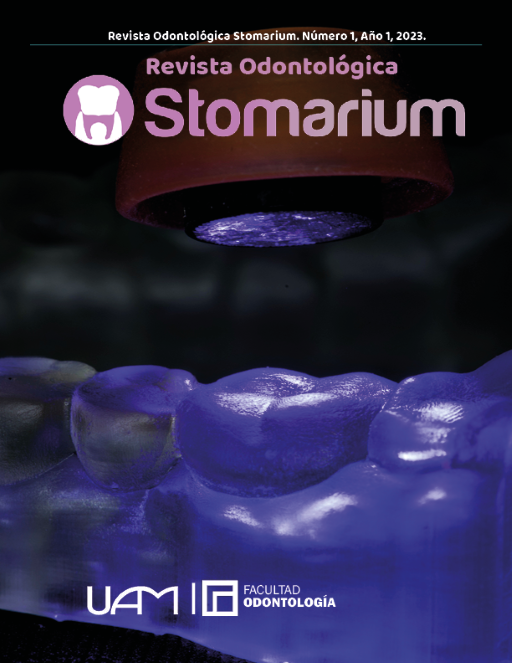Primary closure of unilateral cleft lip. Case report
DOI:
https://doi.org/10.62407/ros.v1i1.88Keywords:
Cleft lip, primary closure, surgical techniquesAbstract
The cleft lip is the most common congenital malformation, which affects structures of the face and oral cavity, due to its characteristics, it implies multidisciplinary management, where the specialist surgeon is one of the relevant components due to the variety of surgical procedures that the patient requires repair of the anomalies present in said primary condition. Objective: To Report the surgical techniques performed in the primary closure of five patients with unilateral cleft lip, according to the systematic surgical protocol used. Material and Method: A descriptive study, case report type, with a qualitative approach, and cross-sectional. The surgical procedures are described in five pediatric patients, younger than 12 months, diagnosed with unilateral cleft lips, operated on during the year 2022, using the Fisher technique and nasal reconstruction for primary closure. The five patients were evaluated individually according to the initial severity index. Results: The immediate postoperative period of five patients with unilateral, non-syndromic cleft lips is shown, in whom a surgical technique for primary closure was performed, based on the anatomical subunits of the lip and nose, described by Fisher, since 2004, which allowed Minimize the visibility of postoperative scars, being essential to obtain satisfactory aesthetic results. Conclusions: For satisfactory primary closure in patients with unilateral cleft lip, the Fisher technique is recommended due to its main advantages, in combination with primary reconstruction of the nasal floor and closure of the alveolar fissure, recommended surgical procedures to achieve satisfactory results in the immediate postoperative period.
References
Aguirre Cabrera H. (2016) Evaluación de resultados postoperatorios en pacientes con queiloplastía unilateral, propuesta del uso de la técnica fisher simplificada [Trabajo de titulación especial para la obtención del postgrado de especialista en cirugía plástica reconstructiva y estética], Universidad de Guayaquil Facultad de Ciencias Médicas. http://repositorio.ug.edu.ec/bitstream/redug/37913/1/CD%20006
Almendárez Mendoza, M. C. (2015) Presencia de anomalías dentarias de forma, tamaño y número en niños que presentan fisura de labio y/ o paladar que asisten a Operación Sonrisa Nicaragua en el período Enero 2013 a Octubre 2014. UNAN-MANAGUA. [Tesis para optar al grado de Cirujano Dentista] RIUMA. http://repositorio.unan.edu.ni/2778/1/74360.pdf
Bojorge Espinoza, Edgar (2008) Prevalencia y factores relacionados con malformaciones congénitas, servicio de neonatología, Hospital Dr. Ernesto Sequeira Blanco, RAAS. Enero 2006 a Diciembre 2007 [Tesis de Maestría]. CIES UNAN Managua. https://repositorio.unan.edu.ni/14727/2/t426.pdf
Bravo, M. (2012) Características sociodemográficas, anomalías bucodentales, y tratamientos ortodónticos, en pacientes con labio fisurado y paladar hendido, atendidos por fundación Nicaplast periodo 2008-2011. León: UNAN-LEÓN. [Tesis para optar a cirujano dentista]. http://riul.unanleon.edu.ni:8080/jspui/handle/123456789/6104
Campbell, A., Restrepo, C., Deshpande, G., Bernstein, S. M., Tredway, C., Wendby, L., & Schonmeyr,
B. (2017). Validation of the Unilateral Cleft Lip Severity Index for Surgeons and Laypersons. Plastic and reconstructive surgery. Global open, 5(9), e1479. https://doi.org/10.1097/GOX.0000000000001479
Carrera E. Martí , J. Redondo Sedano, M. Bazán Legasa, A. Gómez Sánchez, M.D. Delgado Muñoz, (2021) Fisuras orofaciales: Fisura labial y/o palatina, FMC - Formación Médica Continuada en Atención Primaria, Volume 28, pp. 567-572 https://doi.org/10.1016/j.fmc.2020.12.003.
Coiffman, F. (2016). Cirugía Plástica Estética y Reconstructiva. Bogota: Amolca.
Estudio Colaborativo Latino Americano de Malformaciones Congénitas (ECLAMC). (2023) Estudio Colaborativo Latinoamericano de Malformaciones Congénitas. [Sitio Web] http://www.eclamc.org/charlas.html
Fisher, D. M. (2005). Unilateral Cleft Lip Repair: An Anatomical subunit approximation technique.
Plasticand Reconstructive Surgery 116(1): p 61-71. DOI: 10.1097/01.PRS.0000169693.87591.9B.
Fisher DM, Tse R, Marcus J.R. (2008) Objective measurements for grading the primary unilateral cleft lip nasal deformity. Plastic and Reconstructive Surgery. 122(3) doi: 10.1097/PRS.0b013e3181811a52.
Fonseca, R. J. (2016). Oral and Maxillofacial Surgery (2da. ed. Vol. III). SAUNDERSELSEVIER. DOI:9780323444422
Giugliano, C. (1999). Manejo quirúrgico de la fisura labiopalatina. http://www.carlosgiugliano.cl/wpcontent/pdf/cir_pediat_cap_52_manejo_fisura_labio_palatina.pdf
Guillén J., Gutierrez R. (2015). Asociación de factores individuales y sistémicos con fisuras labio-palatinas en pacientes atendidos por el programa Operación Sonrisa Nicaragua en los años 2010-2014. [Tesis para optar a cirujano dentista]. https://repositorio.unan.edu.ni/2792/1/74349.pdf
Hoffman W.Y., &. B. (2021). Diagnóstico y tratamiento en otorrinolaringología. Cirugía de cabeza y cuello. 4e. McGraw Hill. All Rights Reserved. doi:McGraw Hill. https://accessmedicina.mhmedical.com/content.aspx?bookid=3029§ionid=255986539.
MINSA. (2023). Atlas y guía para la detección y descripción de las principales anomalías congénitas. https://www.minsa.gob.ni/publicaciones/direccion-general-de-servicios-de-salud/atlas-y-guia-para-la-deteccion-y-descripcion.
Monasterio, L., Ford, A., Tastets, M. (2016). Fisuras labio palatinas. Tratamiento multidisciplinario. Revista Médica de Clínica Las Condes. doi:10.1016/j.rmclc.2016.01.003.https://www.sciencedirect.com/science/article/pii/S0716864016000043
Noordhoff, M. S. (1997). The surgical Technique for the unilateral Cleft Lip-nasal deformity. Taipei, Noordhoff Craneofacial Foundation.
Pazzetti A., Marie, G., Alas, C., Deras Chacón, G., & Peñalva, D. (2019). Malformaciones congénitas en recién nacidos hospitalizados en sala de neonatología del hospital Nacional Mario Catarino Rivas. San Pedro Sula, Honduras. Acta pediátrica hondureña; 12(1): 1231-1236, https://pesquisa.bvsalud.org/portal/resource/pt/biblio-1378686
Kraudy Montenegro N., Peralta Blandon T. (2017). Caracterización de los hallazgos epidemiológicos de la fisura labiopalatina en recién nacidos vivos en el Hospital Escuela Cesar Amador Molina – Matagalpa. Matagalpa. [Tesis para optar a médico cirujano]. https://repositorio.unan.edu.ni/4851/1/5804.pdf.
Mantilla D, Herrera M., Flores V., Alvarado M. (2020). Manejo integral del paciente con secuelas de labio y paladar hendido en el Servicio de Cirugía Plástica y Reconstructiva ingresados al HEODRA, de abril 2010 a febrero 2013, León. León. [Tesis para optar a cirujano dentista]. http://riul.unanleon.edu.ni:8080/jspui/handle/123456789/8493
Tse R, Lien S. ( 2015). Unilateral Cleft Lip Repair Using the Anatomical Subunit Approximation: Modifications and Analysis of Early Results in 100 Consecutive Cases. Plast Reconstr Surg. 136(1) doi: 10.1097/PRS.0000000000001369. https://pubmed.ncbi.nlm.nih.gov/25829157/
Thongrong C, Sriraj W, Rojanapithayakorn N, Bunsangjaroen P, Kasemsiri P. (2015) Cleft Lip Cleft Palate and Craniofacial Deformities Care: An Anesthesiologist’s Perspective at the Tawanchai Center. J Med Assoc Thai. 98 Suppl 7:S33-7.
Mercan E, Oestreich M, Fisher DM, Allori AC, Beals SP, Samson TD, Sitzman TJ, Matic DB, Siebold BS, Tse RW. (2018) Objective Assessment of the Unilateral Cleft Lip Nasal Deformity Using Three-Dimensional Stereophotogrammetry: Severity and Outcome. Plast Reconstr Surg. 141(4):547e-558e. doi:10.1097/PRS.0000000000004233. https://pubmed.ncbi.nlm.nih.gov/29257001/
Downloads
Published
How to Cite
Issue
Section
License
Copyright (c) 2024 Revista Odontológica Stomarium

This work is licensed under a Creative Commons Attribution-NonCommercial-ShareAlike 4.0 International License.



